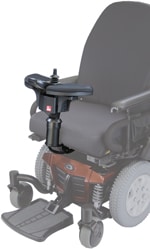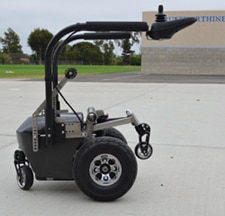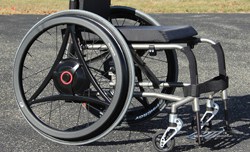
The 29th International Seating Symposium
More than 1,400 rehabilitation professionals came to Nashville, Tenn., to attend the 29th International Seating Symposium hosted by the University of Pittsburgh’s Department of Rehabilitation Science and Technology’s Continuing Education Program. Held this year at the Gaylord Opryland Hotel and Convention Center, March 5-9, the ISS is a yearly educational conference for physical and occupational therapists and assistive technology providers in the seating and mobility field. For rehab professionals, ISS is considered the must-attend event of the year, and also functions as the unofficial annual meeting for clinicians, suppliers, and manufacturers of seating and mobility equipment, many of whom have known each other for years through working in the industry.
This year’s ISS featured over 100 educational sessions and workshops for attendees, covering all aspects of mobility-related disability from choosing the proper wheelchair and seating system to prevention, care and management of pressure ulcers, and aging with a disability. The goal of the sessions is how to maximize the health, mobility and functionality of wheelchair users.
A major feature of every ISS is the exhibit hall, sort of like an Abilities Expo on steroids, where manufacturers showcase their newest products and technology in everything from manual and power chairs, cushions, and accessories to adaptive sports equipment. This year 112 exhibitors filled the 70,000-square-foot exhibit hall. Attendees got the opportunity to experience hands-on evaluation of the latest and greatest in adaptive equipment.

In previous years the exhibit hall was only open to paid attendees (at a cost of $599). But this year, thanks to UsersFirst in partnership with the University of Pittsburgh, the exhibit hall was open to the general public on Wednesday, March 6. “See, Touch, Explore: The Wheelchair User Experience” allowed more than 400 wheelchair users to try the latest equipment, ask questions of manufacturers’ representatives and learn about products that can maximize their health and functionality.
Cool New Stuff
Here is a sampling of the cool, mobility-enhancing equipment that wheelers and clinicians were able to see, touch and experience at this year’s ISS exhibit hall.
Panthera X: Made by Panthera of Sweden, the X is a carbon fiber, rigid chair that weighs in at 9.7 pounds, with a frame weight of 5 pounds, making X the world’s lightest wheelchair [for more details, see this month’s Innovations, page 48]. Panthera has a complete line of rigid lightweight chairs weighing as little as 14.5 pounds. Distributed in North America by Triumph Mobility. Retail: $10,000

ADI AL series rigid back support: When it comes to a combination of light weight, strength, and a vibration dampening ride, nothing beats carbon fiber, something ADI is known for, including their coveted CF (carbon fiber) series solid back supports [see Innovations, page 48]. The ADI AL series solid back supports retain the same shape and quality mounting hardware as the CF series, but the support shell is fabricated from aluminum, which lowers the cost to meet Medicare and private insurance allowables. Available in 10 to 20-inch widths and heights. Suggested retail for standard (16-inch) height AL back: $640
Amovida Motion Comfort + Cushion: The Amovida Motion Comfort + Cushion has a foam base to absorb shock and a unique fluid pad. Amovida’s parent company is Amoena, which also makes breast implants. The fluid pad in the Amovida cushion consists of two layers of silicone gel — the same silicone gel used in breast implants. The main layer is a lesser density gel to reduce sheer, and the top layer is silicone gel infused with phase change material, which was originally developed for NASA astronauts. PCM helps regulate skin temperature, absorbing heat when the skin gets too hot, and releasing it when it cools. The cover has a 3-D breathable mesh top, and the top fabric is interwoven with silver nitrate, which helps regulate bacteria and control smell. Retail: $395

Active Controls JoyBar, ReCharge, and PowerBuddy: The JoyBar center drive system enables a power chair to be driven like a scooter, which some people find easier to control than a joystick. A modular socket set in the center of the chair enables the handlebar-like JoyBar controller to easily drop into place. Retail: $1,996
A cool Active Controls option is the ReCharge adapter, which fits into the same modular socket enabling wheelers with limited or no hand function to charge their batteries. The system fits most power chairs. Retail: $349
The PowerBuddy, another Active Controls device, plugs into the XLR port (on the end of the joystick) and has a USB port to charge everything from cell phones to iPads. Also includes two LED lights. Retail: $119

Spinergy ZX-1: The highly anticipated ZX-1 by Spinergy is a power drive unit that turns a rigid frame manual chair into a joystick-controlled power chair — in seconds. To attach, the user simply backs their manual chair over the unit, and with a press of a button on the joystick, the unit automatically clamps on to the wheelchair’s camber tube and is ready to go. Top speed is 3.2 mph and range is 5 miles. The entire unit with battery weighs 87 pounds, not exactly light, but still light enough to load into the trunk of a car for easy transport. On May 19, the FDA officially approved the ZX-1. Retail: $7,995
 Rowheels: Rowheels presents a unique solution to a common problem for wheelers — shoulder imbalance and damage. Years of pushing forward on hand rims overdevelops big muscles in the front of the shoulders. The weaker muscles in the back of the shoulder can’t compensate, so the shoulder gets pulled forward, out of balance and eventually impinges tendons. Rowheels use gears configured to rotate counter to the hand rim — the user pulls back on the hand rims to move the wheels forward. Pulling on the rims with a rowing motion instead of pushing builds muscles in the back of the shoulder, so the shoulders open up and retain balance. The motion also strengthens and straightens the upper back, creating better posture. In testing trials, new wheelchair users found Rowheels easy to use, whereas seasoned wheelers encountered a learning curve — how steep or shallow varied from person to person. Weight is 6.5 pounds per wheel. Quick-release axles are standard. Available in 22, 24, 25, and 26-inch versions. The company expects to have the first models for sale sometime in the second half of this year. Suggested retail: $2,500-$3,000 a pair.
Rowheels: Rowheels presents a unique solution to a common problem for wheelers — shoulder imbalance and damage. Years of pushing forward on hand rims overdevelops big muscles in the front of the shoulders. The weaker muscles in the back of the shoulder can’t compensate, so the shoulder gets pulled forward, out of balance and eventually impinges tendons. Rowheels use gears configured to rotate counter to the hand rim — the user pulls back on the hand rims to move the wheels forward. Pulling on the rims with a rowing motion instead of pushing builds muscles in the back of the shoulder, so the shoulders open up and retain balance. The motion also strengthens and straightens the upper back, creating better posture. In testing trials, new wheelchair users found Rowheels easy to use, whereas seasoned wheelers encountered a learning curve — how steep or shallow varied from person to person. Weight is 6.5 pounds per wheel. Quick-release axles are standard. Available in 22, 24, 25, and 26-inch versions. The company expects to have the first models for sale sometime in the second half of this year. Suggested retail: $2,500-$3,000 a pair.
Resources:
• Active Controls; www.activecontrols.com
• ADI, 888/684-2234; www.adirides.com
• Amovida, 877/463-9015; www.amovida.us. Distributed by Triumph Mobility, 855/546-0711; www.trumphmobility.com.
• Creating Ability, 507/867-3961; www.creatingability.com
• Panthera X, 855/546-0711; www.triumphmobility.com
• Spinergy ZX-1, 866/517-4501; www.spinergy.com
• Rowheels; www.rowheels.com
Keynote Speech Hits the Mark
Among all of the informative seminars and cool new products, for this writer the highlight of the 2013 ISS was a call to inform and empower wheelchair users in their equipment selection process, delivered in a keynote address by Paul Tobin, president and CEO of United Spinal Association. In my experience as a manufacturer’s rep, supplier, and wheelchair user, I found Tobin’s message, titled “The Patient as an Empowered Consumer: Obstacles and Opportunities for the Rehab Patient in Patient-centered Care,” spot on.
Speaking to a room of 1,400 rehab clinicians and providers, Tobin shared his experience of being an engineer in the U.S. Navy, newly married with a child on the way, when, in 1993, he broke his neck body surfing on a small wave and instantly had to transition from living the American dream to being a quadriplegic. He talked of his experience with patient-centered care as a veteran, explaining his rehab was based on outcome, not arbitrary insurance limits. He was able to stay in rehab until he had maximized his health and functional independence. When he was ready for a power chair, seating system and other adaptive equipment, it was ordered to match his needs and enable him to return to full participation in his community.

Tobin said his VA rehab experience is the model of patient-centered care that he would like to see available to the general public — full rehabilitation and the proper equipment to help people maximize their health and become fully independent. Unfortunately, he said, the rehab model for the general public is far different, driven by third-party payers’ (insurance companies) current trend of a 28-day rehab cycle, then booting people out with severe limits on mobility equipment.
He explained that based on responses to surveys from United Spinal members, the third-party payer system is controlling patient-centered care and in turn controlling the information wheelchair users receive about their equipment options. “We have heard from our members in surveys that they haven’t been informed about the best equipment for them. Rather, they have only been informed of what their coverage will pay for,” he said.
Tobin said it is crucial to inform wheelchair users of the equipment options that best suit their needs. “The right wheelchair and equipment is vital. If you only show them equipment based on insurance reimbursement, not what’s best for them, then they won’t know how to maximize their abilities and independence.” Addressing his audience of clinicians, he went on to say, “You are the specialists in this field, and you have an obligation to make sure the consumers are truly informed. They have a right to know what the obstacle is that’s limiting their choices, whether it is a regulation like an ‘in home’ policy or restrictive insurance policy.”
Tobin drew a sharp distinction between being “patient/client/customer centered” and thinking of wheelchair users as “patients.” Regardless of funding, he said, “When they know the equipment they need, with that knowledge, they will have the capacity to fight for it. Perhaps it will mean fighting for five years until the replacement cycle comes up. Not telling somebody what they can’t get because of funding becomes paternalistic.”
Informing wheelchair users empowers them, stressed Tobin. “Can the patient/client/customer be truly informed with only partial knowledge? Arguments against this are: ‘It is time-consuming. It just frustrates the consumer. It makes the clinician or supplier out to be the bad guy. It won’t help the consumer.’ Nonsense!” he said. “If you want to have a long-term relationship with your consumer, give them the respect you would want yourself. Tell them, ‘Here are the options, here is something you need, but your funding won’t pay for it.’ You aren’t the bad guy! Now you’ve put things in proper context and empowered the customer with the option to fight for the proper funding. Tell them to join UsersFirst!”.
“And,” he concluded, “when you find the person that is so pissed off that they are willing to fight for the proper equipment, let us know, because that’s the person we want to take to Capitol Hill with us. After all, it doesn’t take a lot of us to fight this fight. Ten wheelchairs really screw up the elevators on Capitol Hill!”
Support New MobilityWait! Before you wander off to other parts of the internet, please consider supporting New Mobility. For more than three decades, New Mobility has published groundbreaking content for active wheelchair users. We share practical advice from wheelchair users across the country, review life-changing technology and demand equity in healthcare, travel and all facets of life. But none of this is cheap, easy or profitable. Your support helps us give wheelchair users the resources to build a fulfilling life. |


Recent Comments
Bill on LapStacker Relaunches Wheelchair Carrying System
Phillip Gossett on Functional Fitness: How To Make Your Transfers Easier
Kevin Hoy on TiLite Releases Its First Carbon Fiber Wheelchair